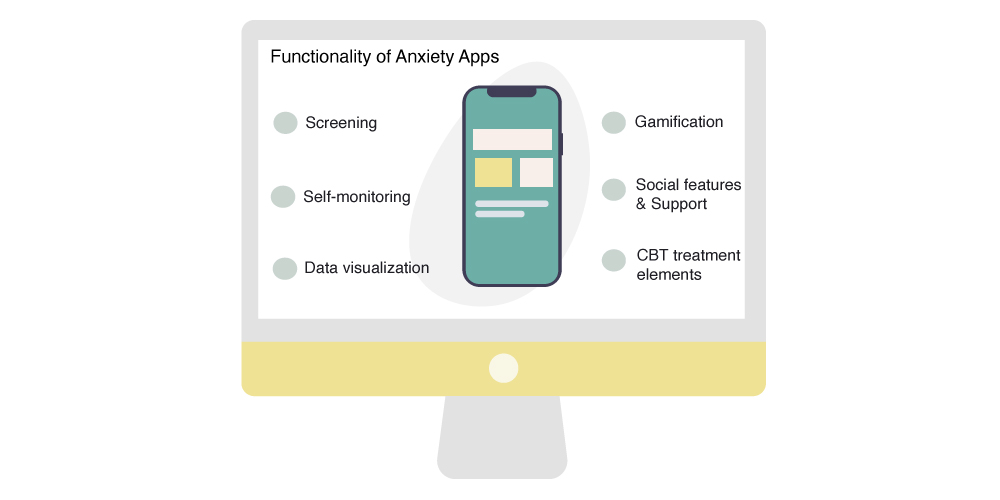An analysis of engagement and tailoring features
In recent years many mobile apps have been developed that aspire to support users with managing anxiety. A large number of these applications are based on Cognitive Behavioral Therapy (CBT) which is an effective treatment for anxiety disorders. Previous work has found people often quickly abandon these applications, as such there is a need to design these applications to be engaging and relevant to the user in order for them to experience the benefits of the treatment. Understanding what these apps actually provide and what strategies they employ to engage and deliver treatment to users is key for the design of usable and effective mental health apps.

In order to examine the functionality of anxiety apps, we conducted a systematic search on Android and Apple marketplaces. We reviewed 36 applications through direct use marketed as using CBT techniques to support the user with anxiety. This paper published in JMIR mHealth and uHealth this year examined the functionality of publicly available mobile apps for anxiety that integrate Cognitive Behavioural Therapy (CBT) with a focus on content delivery, including engagement and tailoring features. In this work, we reviewed how cognitive behavioural elements are delivered by anxiety apps and their functionalities to support user engagement and tailoring based on user needs.
The functionality of mobile apps for anxiety was found to include screening, self-monitoring, visualization of data entries, gamification, social features and support (immediate support and crisis support), and features used to deliver CBT treatment elements. We recorded CBT treatment components, including psychoeducation, cognitive techniques, behavioral techniques, and relaxation skills.

Our review furthermore recorded tailoring features that aim to personalize treatment across different apps. We identified five main types of tailoring functionality: interface customization, treatment-oriented customization, content tailoring offered immediately after installation (app-driven tailoring), tailoring based on self-monitoring entries (mood-driven personalization), and customization of push notifications. We also recorded the use of sensors and the provision of support based on sensor data.

Overall, our results indicated that self-monitoring and visualization were relatively well explored by the apps in the sample in comparison with other feature types. A minority of apps provided some form of human support by integrating a peer support feature or the ability to contact a therapist. The CBT apps identified in this review were designed to support low-intensity CBT exercises. CBT elements use various features, such as audio and video, illustrations, and interactive screens, to increase engagement.
Even though CBT involves the individualization of treatment, the results showed that app-driven therapeutic tailoring is restricted to push notifications and goal selection Similarly, the recommended strategies presented to the users after reporting a particular score in self-monitoring were either generic or identical. Apps do not take advantage of sensing capabilities to adapt treatment delivery over time and sensors were seldom used. Only one app used physiological sensing to monitor heart-rate variability.
To conclude, engagement and tailoring features can be further expanded in existing apps, which currently make limited use of social features and clinical support. We should explore further user needs to enhance the degree of tailored content to individual user needs. We propose that in order to guide the evolution of these interventions, further research is needed to explore the effectiveness of different types of engagement features and approaches to tailoring therapeutic content.
Refer to this publication:
Balaskas, A., Schueller, S. M., Cox, A. L., & Doherty, G. (2021). The Functionality of Mobile Apps for Anxiety: Systematic Search and Analysis of Engagement and Tailoring Features. JMIR mHealth and uHealth, 9(10), e26712.


